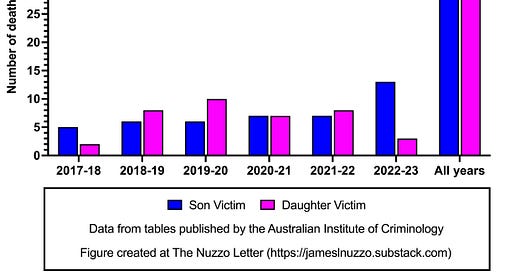This week’s graphs illustrate sex-segregated data on the number of filicide victims and offenders in Australia from 2017-18 to 2022-23.
Are Sons or Daughters More Likely to be Killed by Their Parents?
Each year, about 15 children are victims of filicide in Australia. Roughly the same numbers of sons and daughters are victims of filicide each year. Between 2017-18 to 2022-23, 44 sons and 38 daughters were victims of filicide in Australia.
Is Mom or Dad More Likely to Kill Their Children?
Between 2017-18 to 2022-23, 45 filicides were committed by mom and 37 filicides were committed by dad.
Are Parents of One Sex More Likely to Kill Children of One Sex?
When considering the interaction between the parent’s and child’s sex, the most notable result is that the least common parent-child combination for filicide is dad killing his daughter. Between 2017-2023, there were 14 cases of father-daughter filicide compared to 20-25 cases for the other three parent-child combinations.
Source: Data acquired from annual reports published by the Australian Institute of Criminology.
Bonus Commentary
Filicide, the killing of one’s child, is not common in Australia. When it occurs, sons and daughters are equally likely to be victims, and mom and dad are equally likely to be perpetrators. The least frequently observed perpetrator-victim combination for filicide in Australia is dad-daughter.
In Australia, violence is often portrayed in the media and by government officials as a male perpetrator-female victim paradigm. The above data on filicide do not support the male perpetrator-female victim narrative, as they show that boys are equally likely to victims of filicide as girls, and mom is equally likely or slightly more likely to be the perpetrator of filicide than dad.
SUPPORT THE NUZZO LETTER
If you appreciated this content, please consider supporting The Nuzzo Letter with a one-time or recurring donation. Your support is greatly appreciated. It helps me to continue to work on independent research projects and fight for my evidence-based discourse. To donate, click the DonorBox logo. In two simple steps, you can donate using ApplePay, PayPal, or another service. Thank you!








Fascinating! Thanks Jim.
It's findings like this that makes me wonder about the stereotype that men are more physically aggressive than women.
Is it really a sex differential per se or merely that most people tend to only initiate physical violence against vulnerable targets and women are typically physically weaker and therefore have fewer potential targets than men?
Put another way, if we controlled for the usual size and strength differential between the sexes, would there still be a differential in physical aggression (and if so, would it instead be women with the higher rates of violence)? It looks like it might be that way, given these numbers when the victims are children (and therefore both men and women are comparatively larger and stronger than the vulnerable victims).